Not Quarantining
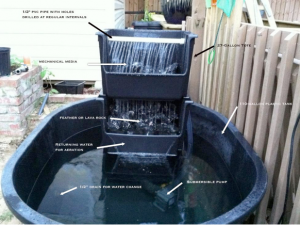 A quarantine tank is probably one of the most singularly important parts of any koi keepers arsenal in stopping the spread of bacteria, viruses and parasites.
A quarantine tank is probably one of the most singularly important parts of any koi keepers arsenal in stopping the spread of bacteria, viruses and parasites.
It is where new koi can be housed and monitored for any signs of sickness before they are added to their new home. It is also where sick fish from the pond can be isolated so as not to infect the rest of the pond. It is less expensive to medicate a quarantine tank than an entire pond.
It doesn’t matter how reputable the source of your koi may be, getting any new koi into a quarantine situation should not even be open to suggestion. It helps your new fish acclimatize, unwind (meaning less stress, thus less likely to pick up a stress-related illness) and give all of your koi the best chance at a smooth transition.
Your quarantine setup doesn’t have to be overly involved (some enthusiasts use a 150gal rubbermaid tub with a bakki shower while others use a kiddie pool with an airstone and frequent water changes.
TIP: you should always have a “canary koi” in your quarantine facility. It introduces the natural flora and fauna from your pond to the new koi as well as being the guinea pig for any parasite or illness the new koi are bringing in.
Different Sources, One QT.
If you have set up a quarantine, almost as dangerous as not QTing, is putting fish from different sources in the same tank or holding facility. Each can bring their own illness or parasites to the tank and create a lethal cocktail for the the whole QT population.
Inadequate Cover
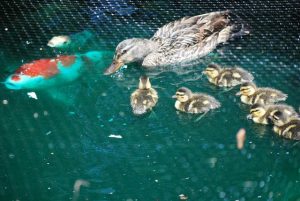
Nervous or stressed koi are jumpy koi. Some just like to jump for no particular reason. And koi can get some serious air. Many a koi owner has come outside to find a koi immobile on the side of pond. Many enthusiasts opt for netting (of which there are many types) as it stops the koi from getting out of the pond, but also allows them to still be able to feed and observe them.
It has the added advantage of deterring predators and stopping larger organic debris from entering the pond, too.
Feeding—Over and Under
Too much food brings it’s own host of problems. Never feed your koi more than they can eat in five minutes. Uneaten food ends up as extra organic waste. This extra organic waste ends up as a tremendous food source for algae.
As a cold-blooded creature, feeding frequency is a function of temperature. The warmer it is, the more frequently you feed and, inversely, reduce them as it gets colder.
Here is an article on feeding schedules for koi fish that might give you a more standardized schedule. It is a generally accepted schedule. Keepers will get to know their own fish and their habits and adjust accordingly.
There are numerous downsides to both under and overfeeding your koi (which we discuss in this post). Feedings shouldn’t generally last any longer than 5 minutes (with many enthusiasts using the 2-3 minute time frame). You don’t want any food sinking to the bottom and clogging up your filters.
TIP: Cheerios and other cereal may look like a treat, but avoid using it to feed your koi.
Types of Food
Not all food is created equal. Even amongst the same brands. To maximize a koi’s health and growth potential, there are differently formulated types of food to accommodate a koi’s nutritional needs.
Dropping the same type of food in all seasons might not be giving your koi all the nutrients the basic building blocks in the correct amounts at the proper times. Here is a look at the ingredients that go into koi food and what their primary function is.
Winter Care
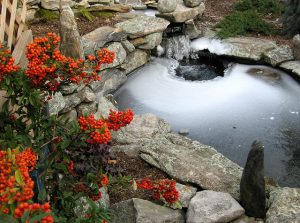
In some parts of the country, winters can be particularly brutal, resulting in a thick layer of ice over the top of the pond—and panic from some owners. Koi are particularly hardy creatures and can survive in some fairly hostile environments. Including ponds that are frozen over.
The real danger for koi comes from deicing efforts by their owners. Especially when owners use concussive force to try and break the ice. Hammering on the ice can kill the koi underneath.
Another common mistake is incorrectly placing an airstone. An airstone’s bubbling can be an effective means of keeping an opening in the ice that allows for gas exchange. However, leaving the airstone on the bottom causes the warmer water there to circulate upwards, mixing with colder water above which can create an unsafe temperature drop for the koi.
Also, a high salt concentration will drop the temperature of the water density (which is ordinarily 39ºF in freshwater) so that the water that sinks to the bottom of the pond once it freezes over will be colder. The higher the salt concentration the lower the maximum water density temperature and the colder the water your koi will be swimming in at the bottom of the pond.
Randomly Adding Medications
Inaccurately assuming or randomly adding medication without knowing what is wrong with your koi is a surefire way to stress your koi, and potentially make it worse than what you are treating for.
It is important to accurately diagnose what the potential sickness is by being aware of the symptoms of illness.
Salt: To Use or Not to Use. This is a hotly debated topic amongst koi keepers. Some feel that—amongst other things—over salting leads to bacterial and parasitic resistance, while others feel the increase in slime coating is beneficial.
In either case, when to use and the amount is paramount. Getting the right concentration is key to the utilizing the benefits. Between 0.1% and 0.3% (for infections) salinity is the usual range recommended.
Asking the Wrong People for Help
There are some tenets in koi keeping that are almost immutable. Yet, any forum that an enthusiast goes to will have differing pieces of advice as to how to go about putting those tenets into action. It can create a lot of confusion for new and experienced koi owners.
The world wide web is a large and woolly place. It is also usually the first place that koi keepers turn when looking for advice or answers. Make sure you check, double check and triple check that what you are being told is accurate. Don’t take action on the first tip that you get.
A koi keeper that thinks they know it all, probably doesn’t. You might find that those who know the most are the ones that ask the smart questions. You want shared experience not unsubstantiated opinion. It is why a lot of enthusiasts that go to local koi shows will remark on the value of relationships that they start there.
Waiting to Ask for Help
If you don’t know, ask. In general, the koi community is very active, especially when rallying around a fellow koi keeper who is in a spot of bother. But if you wait to long to ask, you can risk losing your koi. If you think you have an issue, but aren’t sure, get the help you need. Even though an ounce of prevention is worth a pound of cure, you can save more than a few pounds by getting to the root of the problem more quickly.
Scraping and Scoping
That microscope training in biology class comes in handy as a koi keeper. Learning how to scrape your koi and identify parasites under a microscope can save a lot of hassle and headaches when trying to diagnose why your fish is sick. It takes the guesswork out of which medication to use in your pond or Quarantine Tank. Here is an article on the fundamentals of scraping and scoping a koi fish.
Overstocking
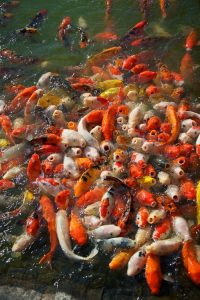 One thing you can rely on, is that your koi will get bigger. Much bigger. You will need to plan accordingly when stocking your pond. According to colorado koi, the modern average size of a fully grown koi is roughly 32inches. You want to give your koi the best opportunity to thrive. A crowded pond will be a stressed pond.
One thing you can rely on, is that your koi will get bigger. Much bigger. You will need to plan accordingly when stocking your pond. According to colorado koi, the modern average size of a fully grown koi is roughly 32inches. You want to give your koi the best opportunity to thrive. A crowded pond will be a stressed pond.
There is only so much space in your pond. And to enjoy a healthy life, you will need to apportion an adequate amount of elbow room for each of your koi.
Here is a chart of gallons per inch that you should keep courtesy drsfostersmith.com
TIP: remember that koi can become quite large in the right conditions. And some breeds, like the Chagoi, are naturally bigger than others. The first two years will see your koi’s growth be the most profound. You can expect your koi to be around 2 feet long at around 4 years of age.
Miscalculating the Pond’s Water Volume
Another important factor that many people overlook is the correct number of gallons their pond actually is. A lot of preventative and curative measures depend heavily on knowing the volume of water in a pond. Get it wrong and in trying to help your koi, you koi could end up doing more harm.
Water changes
 Your koi need them so you need to do them. You will hear stories of people that never change their water and their fish are just fine. That’s because they never asked their fish how they were doing.
Your koi need them so you need to do them. You will hear stories of people that never change their water and their fish are just fine. That’s because they never asked their fish how they were doing.
The amount of water that you substitute out and in depends on numerous factors (like pond
size, number of fish, type of filtration, feeding schedule, organic waste accumulation).
Changing water not only helps to remove some pollutants (which can stunt your koi’s growth) or excess waste, it is important in replenishing trace elements that are used by the inhabitants of the pond’s closed system.
TIP: Consider a constant drip method of water change if you don’t have the time to dedicate to weekly changes. But if you do, check it regularly to make sure the rate is constant and add a dechlorinating filter on the drip line.
The easy rule of thumb is change 10-20% of your pond’s water volume per week. So if you have a 1,200 gallon pond, 120-240 gallons per week should be replaced.
Obviously if your tests reveal undesirable or dangerous levels of pollutants, toxins or organic waste by-products, a higher volume of change will be necessary. However, smaller, frequent changes are less stressful than big changes all at once.
Remember: A water change in a case of high nitrite or nitrate levels only dilutes to less toxic levels. You will still have to find and fix the cause of the elevated levels.
Water Quality
Clear water doesn’t automatically mean clean water. It’s a mistake made by many koi keepers. Especially with new ponds. Your koi can still die in crystal clear water. Even with water that appears clean, the levels of ammonia and nitrites can be high enough to kill your koi quickly.
An uncycled pond can be a dangerous place for koi. Understanding the Nitrogen Cycle and how ammonia (koi waste) is broken down by biological filtration is another vital component of koi keeping. Stay vigilant with your testing even if things appear to be all clear. It is easier to make incremental changes than wholesale ones—and it is easier on the koi, too!
Not Testing Correctly
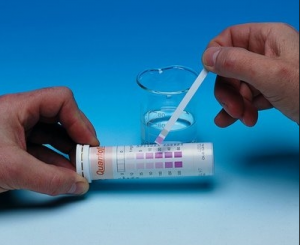 This follows from the last point. Knowing what to test, how to test it and what designates healthy parameters goes a long way in helping to maintain good water quality. It is worth investing in a good testing kit, as even slight fluctuations that aren’t accurately measured can have serious side effects. It also combats against rapid swings in parameters, which koi do not do well with.
This follows from the last point. Knowing what to test, how to test it and what designates healthy parameters goes a long way in helping to maintain good water quality. It is worth investing in a good testing kit, as even slight fluctuations that aren’t accurately measured can have serious side effects. It also combats against rapid swings in parameters, which koi do not do well with.
Important tests and ideal parameters:
- pH—measures how acid, alkaline (or best case, neutral) your pond water is and is measured from 0-14. Between 7 (neutral) and 8.3 (slightly alkaline) is the sweet spot for koi. pH is probably the first thing that should be checked and on at least a weekly basis. If it is acidic (lower than 6.5), it can cause what is a pH crash, and this is what will result in fish loss.
- Ammonia—this is the first byproduct of bacteria breaking down organic waste. Even in low concentrations (as low as 0.25 ppm) can kill your koi. The levels should be at 0.0ppm. Ammonia is more toxic at higher pH levels.
- Nitrite—stage 2 of the Nitrogen Cycle, it can be almost as lethal as ammonia in lower concentrations (0.25ppm). Keep the levels as close to 0.0ppm as possible
- Nitrate – stage 3 of the Nitrogen Cycle. Nitrate is not as harmful as Ammonia and Nitrite but higher levels over a period of time can cause stress. Keep the levels as close to 0.0ppm as possible but less than 5. The only way to reduce/eliminate Nitrates is through water changes.
Not Testing Source Water
This is a rudimentary part of adding water to your pond. Two chemicals, Chlorine and Chloramine, are routinely added to source water by local water authorities in an effort to keep bacteria in check.
Chloramine, in particular, can be dangerous to your koi’s gills and liver—even in small quantities. It may not kill your koi outright, but this can lead to stress, and stress can be the gateway for illness or disease. And with their natural bactericidal capabilities, the two chemicals can also decimate your beneficial bacteria that is vital in maintaining a healthy Nitrogen Cycle.
Thinking That It Won’t Happen To You
You might have read all the literature there is to read and studied at the feet of koi masters, but one thing remains. You will make a mistake. Don’t think you won’t. Experience is the best teacher and it isn’t always kind. Almost every koi enthusiast will speak to how making a mistake ensures that they never make it again—especially when they lose beloved koi.
Everyone will make mistakes, learning how to identify what they are are when they can happen takes patience—and help from those that have been there before. Don’t get despondent by setbacks. Koi keeping is a richly rewarding hobby. Enjoy your Living Jewels!

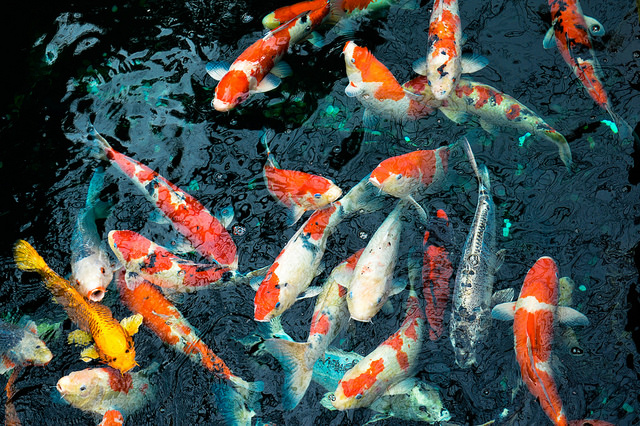
canary in qt does it have to be a koi or can it be a gold fish thks
The canary fish that you use in your QT should be a koi, not a goldfish.
I would like to add one thing TURN OFF your water when done refilling! DO NOT get distracted and forget Many people have lost whole ponds to this oversight. Find some way to remind you you have the water running. I sit by the pond drink coffee and observe my fish when doing water changes.
Great suggestion, thanks!
This goes for draining and flushing filters too. NEVER walk away from a pond that is draining or filling.
Never place a submersible pump in the very bottom. A leak will totally drain your pond. Place the pump a foot or two above the bottom.
Like info on your website….